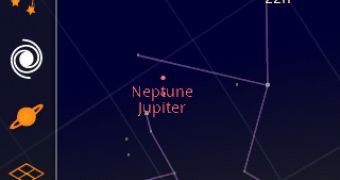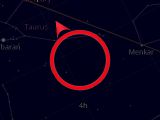Google announced on Tuesday the launch of a new application for the Android operating system, namely Google Sky Map, which, a post on the Google official blog says, is able to transform a mobile phone into a “dynamic window on the night sky.” Basically, the handsets would provide users with a map of the brightest stars, which would also include constellations and planets that are placed on the part of the sky the device is pointed at. In addition, the new application is also able to provide users with the name of stars that catch their attention.
The new Google Sky Map does not offer only location information, just as any GPS-enabled application is now able to provide, but gets the idea even further, enabling Android-powered phones to access a compass reading, along with a series of other sensors, which are meant to determine the direction that the phone is pointed at. The application uses the phone's compass (magnetometer) and the accelerator, as well as the GPS receiver and the time to pinpoint the exact location of a person and to determine the direction it is facing in the Universe.
The feature list of Google Sky Map shows that the application enables users to perform searches, so as to find planets, stars, and constellations directly via the phone, while also including motion detection (creates a window in the sky that moves along with the handset), celestial objects (offers a map of the brightest stars, planets, Sun and Moon, constellation lines, horizon, cardinal points, and Messier Objects), as well as navigation capabilities, allowing them to drag the map with their fingers, or to set it on an automatic mode, when the map is adjusted for view on the phone.
Here is how Google Lat Blog describes the way the new Google Sky Map works on the Android-powered handset: “The phone can't 'see' the stars as such: it works out their positions mathematically from the sensor readings. One quirky consequence of this approach is that Sky Map doesn't need a line-of-sight to find the stars and planets. It will just as reliably display stars you can't see on a cloudy night, stars you can't see because the Sun is shining, stars you can't see because you're indoors, and even stars in the opposite hemisphere that you can't see because the Earth itself is in the way.”
In addition to offering all these pieces of information, Google Sky Map features a very small core data model. Given the fact that the star data is pretty stable in time, the development team says that it has managed to fit “all of Sky Map's core data into a tiny 60K,” while also adding that it comes for free with the application, and might not need any update during the lifetime of the phone. Moreover, it can be used at all times, no matter where you are, and it will be able to show you what cannot be usually seen by the human eye. Those that would like to try out all the features of Google Sky Map on their mobile phones can download it from the Android Market.

 14 DAY TRIAL //
14 DAY TRIAL // 
